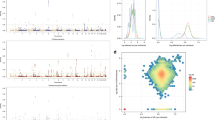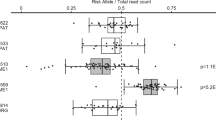Abstract
Copy number variation (CNV) is becoming increasingly important as a feature of human variation in disease susceptibility studies. However, the consequences of CNV are not so well understood. Here, we present data exploring the functional consequences of CNV of CCL3L1 in 55 independent UK samples with no known clinical phenotypes. The copy number of CCL3L1 was determined by the paralogue ratio test, and expression levels of macrophage inflammatory protein-1α (MIP-1α) and mRNA from stimulated monocytes were measured and analysed. The data show no statistically significant association of MIP-1α protein levels with copy number. However, there was a significant correlation between copy number and CCL3L1:CCL3 mRNA ratio. The data also provide evidence that expression of CCL3 predominates in both protein and mRNA, and therefore the observed variation of CCL3 is potentially more important biologically than that of CNV of CCL3L1.
This is a preview of subscription content, access via your institution
Access options
Subscribe to this journal
Receive 6 digital issues and online access to articles
$119.00 per year
only $19.83 per issue
Buy this article
- Purchase on Springer Link
- Instant access to full article PDF
Prices may be subject to local taxes which are calculated during checkout







Similar content being viewed by others
References
Stranger BE, Forrest MS, Dunning M, Ingle CE, Beazley C, Thorne N et al. Relative impact of nucleotide and copy number variation on gene expression phenotypes. Science 2007; 315: 848–853.
Henrichsen CN, Vinckenbosch N, Zollner S, Chaignat E, Pradervand S, Schutz F et al. Segmental copy number variation shapes tissue transcriptomes. Nat Genet 2009; 41: 424–429.
Modi WS . CCL3L1 and CCL4L1 chemokine genes are located in a segmental duplication at chromosome 17q12. Genomics 2004; 83: 735–738.
Irving SG, Zipfel PF, Balke J, McBride OW, Morton CC, Burd PR et al. Two inflammatory mediator cytokine genes are closely linked and variably amplified on chromosome 17q. Nucleic Acids Res 1990; 18: 3261–3270.
Berkman N, John M, Roesems G, Jose PJ, Barnes PJ, Chung KF . Inhibition of macrophage inflammatory protein-1 alpha expression by IL- 10. Differential sensitivities in human blood monocytes and alveolar macrophages. J Immunol 1995; 155: 4412–4418.
Standiford T, Kunkel SL, Liebler JM, Burdick MD, Gilbert AR, Strieter RM . Gene expression of macrophage inflammatory protein-1 alpha from human blood monocytes and alveolar macrophages is inhibited by interleukin-4. Am J Respir Cell Mol Biol 1993; 9: 192–198.
Menten P, Struyf S, Schutyser E, Wuyts A, De Clercq E, Schols D et al. The LD78b isoform of MIP-1a is the most potent CCR5 agonist and HIV-1-inhibiting chemokine. J Clin Invest 1999; 104: R1–R5.
Choe H, Farzan M, Sun Y, Sullivan N, Rollins B, Ponath PD et al. The [beta]-Chemokine receptors CCR3 and CCR5 facilitate infection by primary HIV-1 isolates. Cell 1996; 85: 1135–1148.
Alkhatib G, Combadiere C, Broder CC, Feng Y, Kennedy PE, Murphy PM et al. CC CKR5: A RANTES, MIP-1alpha, MIP-1beta Receptor as a Fusion Cofactor for Macrophage-Tropic HIV-1. Science 1996; 272: 1955–1958.
Aquaro S, Menten P, Struyf S, Proost P, Van Damme J, De Clercq E et al. The LD78b Isoform of MIP-1a Is the Most Potent CC-Chemokine in Inhibiting CCR5-dependent human immunodeficiency virus type 1 replication in human macrophages. J Virol 2001; 75: 4402–4406.
Xin X, Shioda T, Kato A, Liu H, Sakai Y, Nagai Y . Enhanced anti-HIV-1 activity of CC-chemokine LD78[beta], a non-allelic variant of MIP-1[alpha]/LD78[alpha]. FEBS Letters 1999; 457: 219–222.
Shostakovich-Koretskaya L, Catano G, Chykarenko ZA, He W, Gornalusse G, Mummidi S et al. Combinatorial content of CCL3L and CCL4L gene copy numbers influence HIV-AIDS susceptibility in Ukrainian children. AIDS 2009; 23: 679–688.
Gonzalez E, Kulkarni H, Bolivar H, Mangano A, Sanchez R, Catano G et al. The influence of CCL3L1 gene-containing segmental duplications on HIV-1/AIDS susceptibility. Science 2005; 307: 1434–1440.
Dolan MJ, Kulkarni H, Camargo JF, He W, Smith A, Anaya J-M et al. CCL3L1 and CCR5 influence cell-mediated immunity and affect HIV-AIDS pathogenesis via viral entry-independent mechanisms. Nat Immunol 2007; 8: 1324–1336.
Kulkarni H, Marconi VC, Agan BK, McArthur C, Crawford G, Clark RA et al. Role of CCL3L1-CCR5 genotypes in the epidemic spread of HIV-1 and evaluation of vaccine efficacy. PLoS ONE 2008; 3: e3671.
Ahuja SK, Kulkarni H, Catano G, Agan BK, Camargo JF, He W et al. CCL3L1-CCR5 genotype influences durability of immune recovery during antiretroviral therapy of HIV-1-infected individuals. Nat Med 2008; 14: 413–420.
He W, Kulkarni H, Castiblanco J, Shimizu C, Aluyen U, Maldonado R et al. Reply to: ″CCL3L1 and HIV/AIDS susceptibility″ and ″experimental aspects of copy number variant assays at CCL3L1″. Nat Med 2009; 15: 1117–1120.
Huik K, Sadam M, Karki T, Avi R, Krispin T, Paap P et al. CCL3L1 copy number is a strong genetic determinant of HIV Seropositivity in caucasian intravenous drug users. J Infect Dis 2010; 201: 730–739.
Urban TJ, Weintrob AC, Fellay J, Colombo S, Shianna KV, Gumbs C et al. CCL3L1 and HIV/AIDS susceptibility. Nat Med 2009; 15: 1110–1112.
Fellay J, Ge D, Shianna KV, Colombo S, Ledergerber B, Cirulli ET et al. Common genetic variation and the control of HIV-1 in humans. PLoS Genet 2009; 5: e1000791.
Shao W, Tang J, Song W, Wang C, Li Y, Wilson CM et al. CCL3L1 and CCL4L1: variable gene copy number in adolescents with and without human immunodeficiency virus type 1 (HIV-1) infection. Genes Immun 2007; 8: 224–231.
Bhattacharya T, Stanton J, Kim E-Y, Kunstman KJ, Phair JP, Jacobson LP et al. CCL3L1 and HIV/AIDS susceptibility. Nat Med 2009; 15: 1112–1115.
Walker S, Janyakhantikul S, Armour JAL . Multiplex paralogue ratio tests for accurate measurement of multiallelic CNVs. Genomics 2009; 93: 98–103.
Townson JR, Barcellos LF, Nibbs RJ . Gene copy number regulates the production of the human chemokine CCL3-L1. Eur J Immunol 2002; 32: 3016–3026.
Field SF, Howson JMM, Maier LM, Walker S, Walker NM, Smyth DJ et al. Experimental aspects of copy number variant assays at CCL3L1. Nat Med 2009; 15: 1115–1117.
Armour JAL, Palla R, Zeeuwen PLJM, den Heijer M, Schalkwijk J, Hollox EJ . Accurate, high-throughput typing of copy number variation using paralogue ratios from dispersed repeats. Nucleic Acids Res 2007; 35: e19.
Carpenter D, Walker S, Prescott N, Schwalkwijk J, Armour JAL . Accuracy and differential bias in copy number measurement of CCL3L1. BMC Genomics 2011; 12: 418.
Acknowledgements
This work and DC was supported by a Wellcome Trust grant (number 083929) awarded to JALA and RJP.
Author information
Authors and Affiliations
Corresponding author
Ethics declarations
Competing interests
The authors declare no conflict of interest.
Additional information
Supplementary Information accompanies the paper on Genes and Immunity website
Rights and permissions
About this article
Cite this article
Carpenter, D., McIntosh, R., Pleass, R. et al. Functional effects of CCL3L1 copy number. Genes Immun 13, 374–379 (2012). https://doi.org/10.1038/gene.2012.5
Received:
Revised:
Accepted:
Published:
Issue Date:
DOI: https://doi.org/10.1038/gene.2012.5
Keywords
This article is cited by
-
Copy number variation of CCL3L1 among three major ethnic groups in Malaysia
BMC Genetics (2020)
-
CCL3L1 copy number, CCR5genotype and susceptibility to tuberculosis
BMC Medical Genetics (2014)
-
CCL3L1 copy number, HIV load, and immune reconstitution in sub-Saharan Africans
BMC Infectious Diseases (2013)
-
Influence of intragenic CCL3 haplotypes and CCL3L copy number in HIV-1 infection in a sub-Saharan African population
Genes & Immunity (2013)



